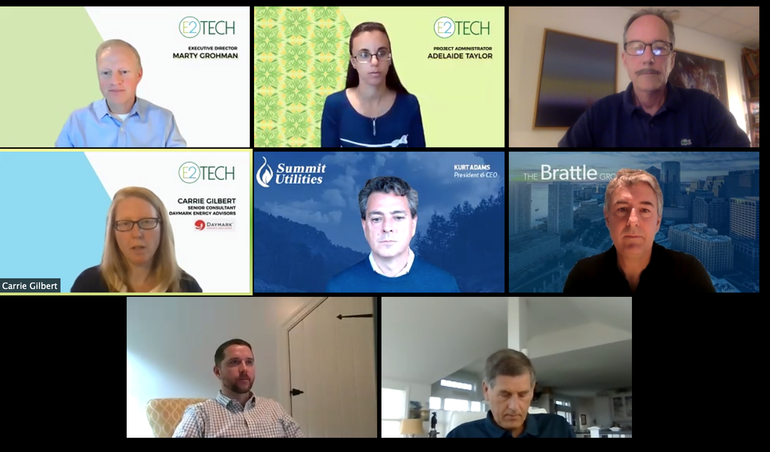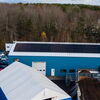Climate goals discussion shifts from fuel costs to infrastructure costs
 Screenshot
Top right, Richard Perez of SUNY-Albany was a panelist for E2Tech's webinar on “Blueprint for a Zero Carbon Economy: Achieving Maine's Climate Goals.”
Screenshot
Top right, Richard Perez of SUNY-Albany was a panelist for E2Tech's webinar on “Blueprint for a Zero Carbon Economy: Achieving Maine's Climate Goals.”
An “all of the above” approach is likely needed to increase Maine's renewable energy portfolio to 80% by 2040 and a goal of 100% by 2050, and thereby cut greenhouse gas emissions by 45% by 2040 and at least 80% by 2050.
That was the essence of a discussion about possible pathways to a fossil fuel free economy, and about whether the approach is reasonable, achievable and economical.
The discussion was hosted this morning by E2Tech in a webinar called “Blueprint for a Zero Carbon Economy: Achieving Maine's Climate Goals.”
A panel of experts agreed that achieving the emissions reductions goals of the Maine Climate Council hinges on dramatically reducing reliance on fossil fuels, not just for home heating, but in all sectors of the Maine economy. It relies on a large-scale shift from fossil fuels to an expanded electricity grid powered mainly by new renewables.
Panelists laid out what is needed in terms of investment and structure, including solar, wind, energy storage development.
The Maine Climate Council was created last year by Gov. Janet Mills’ administration. The council is responsible for helping the state meet goals for cutting greenhouse gas emissions, boosting renewable energy use, and making the Maine economy carbon-neutral.
Beneficial electrification
Richard Silkman, CEO of Competitive Energy Services in Portland, has drafted a plan to achieve 100% renewable energy and zero carbon emissions by 2050, without jeopardizing the health and vitality of Maine’s economy.
Silkman discussed a concept called “beneficial electrification” that would decarbonize electrical generation through a build-out of renewable generation systems combined with large-scale battery storage systems, along with commensurate expansion of the transmission and distribution grid.
Eliminating CO2 emissions means converting all energy use to electricity, he said.
In northern climates especially, peak and total energy loads are driven by heating demand, he noted.
“Heating becomes a very important factor in looking at electrification,” he noted.
Silkman’s plan establishes a conversion rate that would see 60% of all passenger cars in Maine would be electric vehicles by 2040, and 100% by 2050. Residential conversion would depend on the use of air source heat pumps.
Renewable energy would depend on four primary sources, he said: onshore and offshore wind, solar and hydropower.
“If you want to move to 100% renewables in Maine, you need wind,” he said. “Solar alone won’t cut it because most of our load is in the winter,” when the days are short and sunshine intermittent.
Silkman looked at a mix of resources that would be viable in combination with battery storage requirement under various scenarios.
Running a battery storage system based on 100% solar energy would require 4 million megawatt hours of battery storage, the equivalent of 60 million Tesla batteries.
Combining solar with onshore wind reduces storage requirements considerably, thus lowering costs, he said; and adding offshore wind further lowers costs.
“The ability to locate solar just about anywhere in Maine makes it a fungible resource,” he added.
Fuel versus capital costs
Building out a resource mix achieves overall capital costs that are “fairly reasonable,” he said.
Today’s energy costs mainly depend on the variable costs of fuel, Silkman said. Maine has paid on average about $6 billion for energy in all forms over the last 20 years.
“Today most of our costs are fuel costs,” he said. “We have delivery and supply costs, very little generation and effectively zero battery storage.”
Conversion to renewable swaps in fixed capital costs to build infrastructure and battery storage and expand the electrical grid, and essentially eliminates fuel costs.
The yearly capital required to achieve the conversion would be significant, amounting to $2 billion per year on average over the next 30 years, for a total of $60 billion, Silkman said.
“This is important because, in the old world, we look to the cheapest sources of fuel we can find” in the form of fossil fuels. “In the world of the future, what we have to look for is the cheapest capital cost, because capital will drive this conversion. So we have to figure out ways in which we can acquire the capital necessary to make this conversion in as cheaply and efficiently a manner as possible.”
Shifting the cost accordingly will make it possible to eliminate Maine’s carbon emissions by 2050, he said.
“And we can do it without bankrupting Maine,” he said.
Solar dwarfs everything
The potential for solar photovoltaics dwarfs all renewable energy sources “by orders of magnitude,” said Richard Perez, a senior research associate at the State University of New York at Albany.
The wind potential is also strong worldwide and could potential power the planet, he said.
Other renewable sources, including tidal, biomass, hydro and geothermal, are relatively small or inefficient sources.
“Between solar and wind, we have a big solution,” he said.
But conversion is not going as quickly as it could. That’s due to two primary reasons: intermittency of the resources and lack of clear government policy. Transforming intermittency to permanent availability of electricity means creating viable storage systems.
“It looks hopeless unless we think outside the box,” Perez said.
One solution, he continued, would mean overbuilding solar and wind systems so that they generate enough electricity to feed storage systems.
New solutions, he said, also mean bringing grid operators into the system as partners that will benefit from monetized renewable energy systems.
“Solar systems have to support the grid,” he said.
The footprint for expanding solar to meet 2050’s goals is not large. Assuming Maine develops a mix dominated by 55% solar (with 40% wind and 5% natural gas), solar build out would take up about 14 square miles, he said.
“It would not be far fetched to take a few square kilometers from the woods and use them for clean energy,” Perez said. “There is so much space you could even consider doing away with wind and gas and do 100% PV.”
He added, “So we have a big solution and we can transform that into an action plan. At least 75% of the problem can be resolved with PV and wind.”
Mainebiz web partners
Better watch Michael Moore's Planet of the Humans before you get too carried away. (And before Youtube censors it again due to corporate outcry. It had over nine million views before it was taken off, and just recently was put back on.) Reveals a lot of the flaws in your plans.










1 Comments